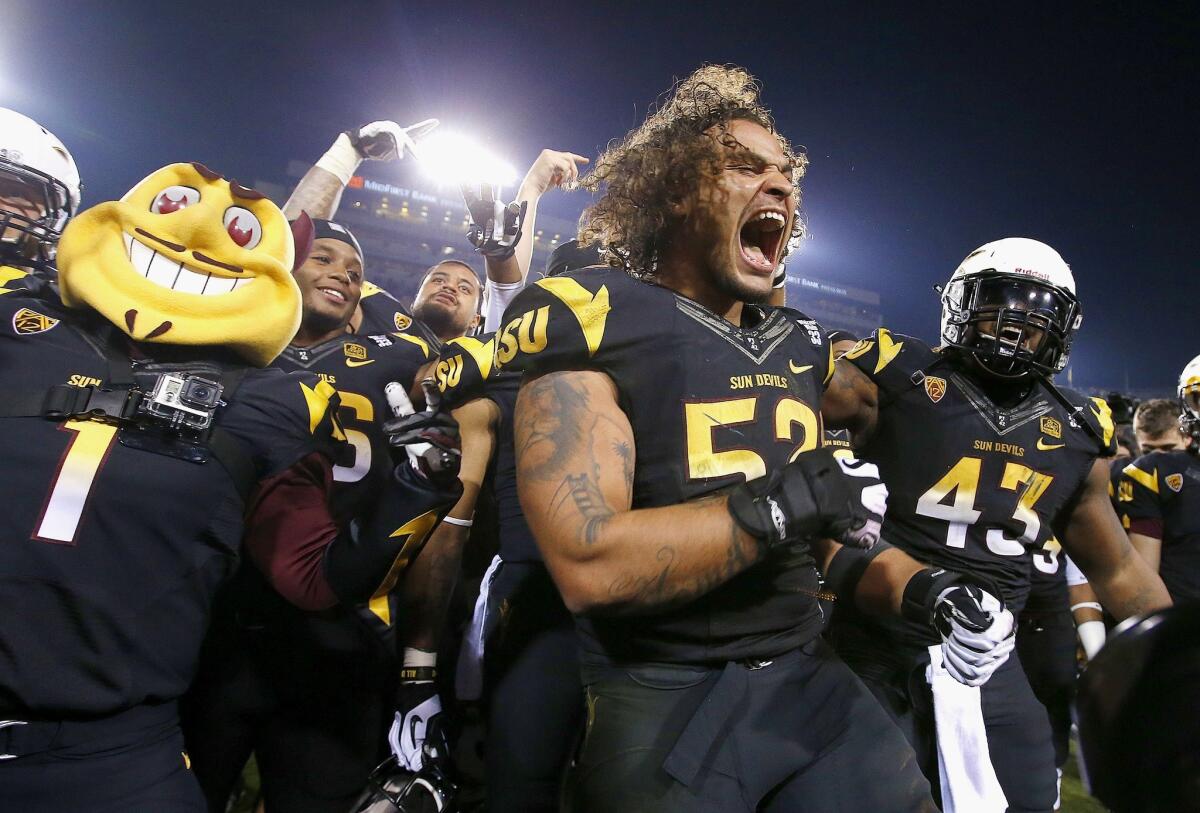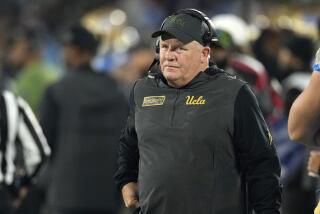Pac-12 Championship: Hits to Arizona State’s helmets closely watched

- Share via
Authorities can test a driver’s blood to see if the person’s mind is too impaired by alcohol to hit the road. But sports officials lack a similar test to check when a football player is too concussed to be on the field.
Arizona State players, in action Saturday night against Stanford in the Pac-12 championship, have been season-long guinea pigs in an effort to develop a test. The blood, saliva and urine of 36 players has been regularly collected since the preseason. All of the players, most of whom are starters, volunteered.
Fluid samples are being compared against data from Riddell impact sensors worn inside helmets since the first contact practice of the season. Of most interest are players who have received the hardest hits, the most hits and the handful of players who have been clinically diagnosed with concussions this season.
The goal is to see whether molecules floating around in any one of the fluids indicate the presence of a head injury, said Matt Huentelman, associate professor of the neurogenomics lab at Phoenix’s Translational Genomics Research Institute.
“We’re most interested in solving the problem of head injuries that don’t manifest in symptoms or are missed by the trainers,” Huentelman said. “There are enough of them that are missed or hidden by the athletes that we should be concerned. “
Finding a bio-marker would be a major milestone in the intensifying controversy over the consequences of playing football. Experts say many of the worst head injuries, or deaths, occur when players return to action before they are fully recovered. A biological test, like a blood-alcohol level test, could allow athletic trainers to confidently give an all-clear sign. Now, players return to play 24 hours after showing zero qualitative concussion symptoms.
In the fluids, researchers are studying RNA, which contain the blueprints for proteins, and proteins themselves. RNA molecules can be digitally measured and read in ways that were not possible a few years ago, which is why they have begun to be analyzed in the context of concussions. Protein reading remains a difficult proposition because with so many of them, it’s hard to know which one to analyze.
In the end, it’s likely that a combination of bio-markers will provide a “signature” for when someone is objectively injured and objectively recovered, said another researcher, Dr. Javier Cardenas at the Barrow Neurological Institute in Phoenix. He’s also involved with a parallel study analyzing the same biological fluids from about 15 Arizona youth football players with clinical concussions.
“The holy grail for concussions is finding that objective measure,” Cardenas said. “We have to know whether people are suffering damage to the brain even though their brains are not telling them they have suffered injuries.”
Viewers of the Pac-12 championship might be able to spot the science in action if they notice a couple of people next to a big briefcase with a computer and antenna on the Arizona State sideline. The machine records data from the helmet sensors and has been a presence at every Sun Devil practice and game.
Analysis won’t begin until Arizona State’s season is complete, and Huentelman said it could be a year or more before preliminary results are available.
“We strongly believe we’ll find something,”Huentelman said. “Most scientists you run into are optimists.”
The search, believed to be the only project of its kind, is being funded by sources that include federal grants and private, undisclosed donations. The football team has not absorbed any costs.
Arizona State football spokesman Thomas Lennenberg said the players don’t mind the probing.
“They see it as their duty to help out the next generation of guys,” Lennenberg said. “They want to feel like they did their part.”
ALSO:
NFL players’ brains at work show early signs of concussions’ toll
Ten former NHL players file suit over lack of concussion information
Study: No helmet brand can save football players from concussion risk
More to Read
Go beyond the scoreboard
Get the latest on L.A.'s teams in the daily Sports Report newsletter.
You may occasionally receive promotional content from the Los Angeles Times.











